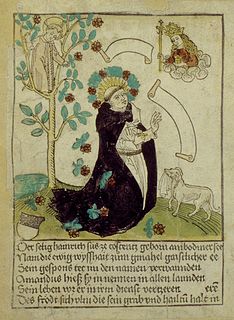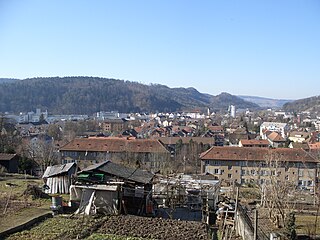
Theobald the Great (1090–1152) was Count of Blois and of Chartres as Theobald IV from 1102 and was Count of Champagne and of Brie as Theobald II from 1125.
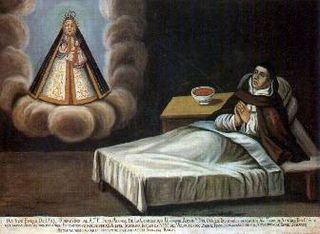
Christian mysticism refers to the development of mystical practices and theory within Christianity. Mysticism is not so much a doctrine as a method of thought. It has often been connected to mystical theology, especially in the Roman Catholic and Orthodox Christianity.
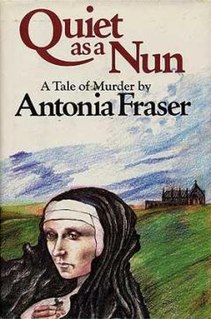
Quiet as a Nun is a thriller novel, written by Antonia Fraser. First published in 1977, it features Fraser's sleuthing heroine Jemima Shore as she revisits the convent school where she was educated following the mysterious death of one of the nuns. A six-part television dramatisation of the book was part of ITV's anthology series Armchair Thriller in 1978.

Johannes Tauler OP was a German mystic, a Catholic preacher and a theologian. A disciple of Meister Eckhart, he belonged to the Dominican order. Tauler was known as one of the most important Rhineland mystics. He promoted a certain neo-platonist dimension in the Dominican spirituality of his time.

Agnes of Bohemia, O.S.C.,, also known as Agnes of Prague, was a medieval Bohemian princess who opted for a life of charity, mortification of the flesh and piety over a life of luxury and comfort. Although she was venerated soon after her death, Agnes was not beatified or canonized for over 700 years.
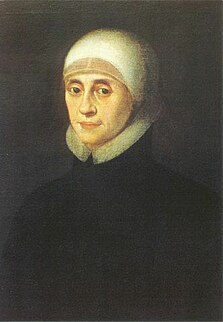
Mary Ward, I.B.V.M., was a Catholic nun whose activities led to the founding of the Congregation of Jesus and the Institute of the Blessed Virgin Mary, better known as the Sisters of Loreto, which have both established schools around the world. Ward was declared Venerable by Pope Benedict on 19 December 2009.
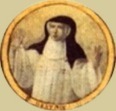
Blessed Beatrice of Nazareth or in Dutch Beatrijs van Nazareth was a Flemish Cistercian nun. She was the very first prose writer using an early Dutch language, a mystic, and the author of the notable Dutch prose dissertation known as the Seven Ways of Holy Love. She was also the first prioress of the Abbey of Our Lady of Nazareth in Nazareth near Lier in Brabant.

The Friends of God was a medieval mystical group of both ecclesiastical and lay persons within the Catholic Church and a center of German mysticism. It was founded between 1339 and 1343 during the Avignon Papacy of the Western Schism, a time of great turmoil for the Catholic Church. The Friends of God were originally centered in Basel, Switzerland, and were also fairly important in Strasbourg and Cologne. Some late-nineteenth century writers made large claims for the movement, seeing it both as influential in fourteenth-century mysticism, and as a precursor of the Protestant Reformation. Modern studies of the movement, however, have emphasised the derivative and often second-rate character of its mystical literature, and its limited impact on medieval literature in Germany.

Hadewijch was a 13th-century poet and mystic, probably living in the Duchy of Brabant. Most of her extant writings are in a Brabantian form of Middle Dutch. Her writings include visions, prose letters and poetry. Hadewijch was one of the most important direct influences on John of Ruysbroeck.

Mary of Hungary, of the Árpád dynasty, was Queen consort of the Kingdom of Naples. She was a daughter of Stephen V of Hungary and his wife Elizabeth the Cuman. Mary served as Regent in Provence in 1290–1294 and in Naples in 1295–96, 1296–98, and 1302, during the absences of her consort.

Maria Laskarina was a Queen consort of Hungary by marriage to Béla IV of Hungary. She was the daughter of Theodore I Laskaris and Anna Angelina.

Constance of Hungary was the second Queen consort of Ottokar I of Bohemia.
Agnes Blannbekin, was an Austrian Beguine and Christian mystic. She was also referred to as Saint Agnes Blannbekin or the Venerable Agnes Blannbekin, though never beatified or canonized by the Roman Catholic Church. Her revelations were compiled by an anonymous confessor before being transcribed by the monk Ermenrich and later published in 1731 as Venerabilis Agnetis Blannbekin. The copies were confiscated by the Society of Jesus, and only two manuscripts survived. One was destroyed in a fire at the Strasbourg library in 1870. The surviving manuscript, currently owned by a Cistercian convent in Zwettl, Austria, was not released until the 20th century. Although Blannbekin is best remembered today for her visions, during her life she was known for her ministry to the urban population and her strange and provocative expressions of faith.

Agnes of Jesus, O.P., was a French Catholic nun of the Dominican Order. She was prioress of her monastery at Langeac, and is today venerated in the Roman Catholic Church, having been beatified by Pope John Paul II on November 20, 1994.

Töss Monastery was a community of Dominican nuns located in the former Swiss city of Töss, now a part of Winterthur. Nothing of the original buildings exists today.
Sister-books is the term for a group of texts in the medieval literature. These works were written by Dominican nuns in the first half of the fourteenth century in South Germany and Switzerland. They relate the mystical experiences of sisters within the monastery, and were influential in the development of medieval mysticism.



